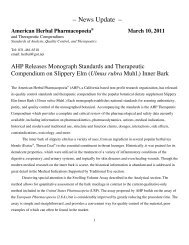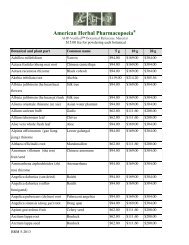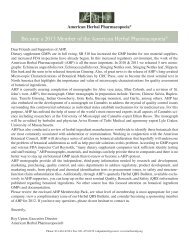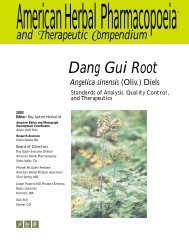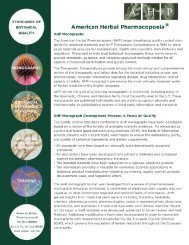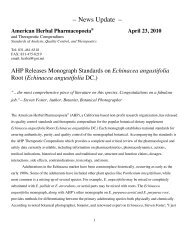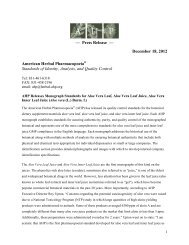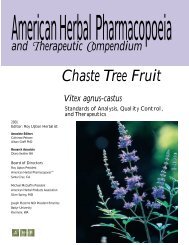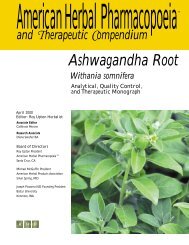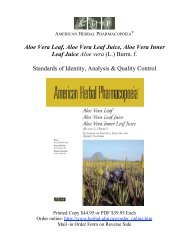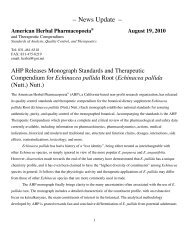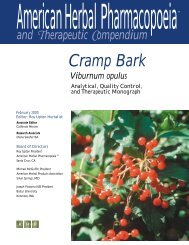alerian oot - American Herbal Pharmacopoeia
alerian oot - American Herbal Pharmacopoeia
alerian oot - American Herbal Pharmacopoeia
You also want an ePaper? Increase the reach of your titles
YUMPU automatically turns print PDFs into web optimized ePapers that Google loves.
Stationary Phase:<br />
Mobile Phase:<br />
Sample Application:<br />
Detection:<br />
R f Values:<br />
Assay for Volatile Oil<br />
There are three primary methods applicable for assaying volatile oil content of v<strong>alerian</strong><br />
r<strong>oot</strong>: AOAC International, European <strong>Pharmacopoeia</strong>, and the United States<br />
Pharmacopeia. Each of these is similar; however, the procedures provided by AOAC<br />
have been detailed in such a manner as to minimize variables that can lead to differences<br />
in volatile oil yields and maximize reproducibility (Ertl 1997). Because the<br />
determination of volatile oil is the primary qualitative and quantitative marker for<br />
effective v<strong>alerian</strong> products, this method has been adopted (see Ertl Journal AOAC Int<br />
80(4): 1-6, 1997).<br />
Thin Layer Chromatography (TLC, HPTLC)<br />
For thin layer chromatography analysis, the method of the European <strong>Pharmacopoeia</strong><br />
(1998 supplement) and the method proposed by the United States Pharmacopeial<br />
Convention (USP) (Pharmacopeial Forum 1998) were compared. The method of<br />
the European <strong>Pharmacopoeia</strong> method was preferred for analysis of valerenic acid, a<br />
primary marker compound of V. officinalis. Improvements were made to the sample<br />
preparation.<br />
Sample Preparation<br />
Shake 0.2 g of freshly powdered v<strong>alerian</strong> in a test tube with 5 mL dichloromethane<br />
for 1 minute. Allow the mixture to stand for 5 minutes and then filter. Wash the filter<br />
with 2 mL of dichloromethane. Evaporate the combined filtrate and washing to<br />
dryness on a water bath. Dissolve the residue in 0.2 mL of dichloromethane and<br />
transfer the solution into a small sample vial.<br />
Standard Preparation<br />
Dissolve 1 mg of valerenic acid (available from Indofine Chemical Company,<br />
Somerville, NJ; United States Pharmacopeial Convention, Rockville, MD) in 0.5<br />
mL of dichloromethane.<br />
Reagent Preparation<br />
Prepare HCl-acetic acid reagent (1:4) carefully mixing 20 mL of glacial acetic acid<br />
with 80 mL of concentrated hydrochloric acid.<br />
Prepare anisaldehyde-sulfuric acid reagent by slowly adding 9 mL of 98% H 2SO 4<br />
to an ice cooled mixture of 85 mL of methanol and 10 mL of glacial acetic acid. To<br />
this solution add 0.5 mL of anisaldehyde and mix well. The anisaldehyde-sulfuric<br />
acid reagent is colorless and should be stored in a refrigerator. If a color develops, the<br />
reagent must be discarded.<br />
Chromatographic Conditions<br />
HPTLC plates 10 x 10 cm silica gel 60 with fluorescence indicator (EM Science,<br />
Whatman, Machery & Nagel, or equivalent).<br />
Hexane:ethyl acetate:glacial acetic acid (65:35:0.5).<br />
3 µl volumes of both sample solution and standard are applied each as a 10 mm<br />
band. Space bands 6 mm apart. Application position should be 8 mm from the lower<br />
edge of the plate.<br />
a) UV 254 nm.<br />
b) Spray plate with the HCl-acetic acid reagent, dry in stream of cold air, heat to 110<br />
˚C for 5 minutes. Inspect plate in visible light and under UV 366 nm.<br />
c) Spray the plate with the HCl-acetic acid reagent, dry in stream of cold air, place<br />
on plate heater (or in oven) at 120 ˚C for 2 minutes (or until color of standard has<br />
developed).<br />
Valerenic acid = 0.48. Following application of the HCl-acetic acid reagent, this<br />
band appears as a very faint violet color in visible light and as a weak fluorescent band<br />
under UV 366 nm. Following subsequent application of the anisaldehyde-sulfuric<br />
acid reagent, valerenic acid appears as a strong dark blue band.<br />
<strong>American</strong> <strong>Herbal</strong> <strong>Pharmacopoeia</strong> • V<strong>alerian</strong> R<strong>oot</strong> • April 1999 Page 9



